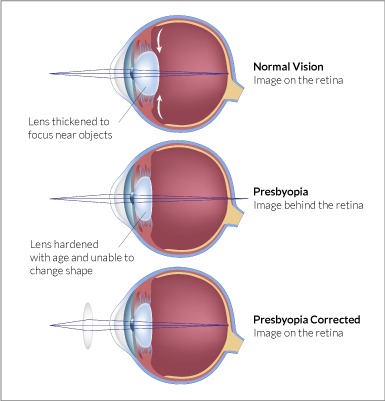
What is presbyopia?
Presbyopia is a common type of vision disorders that onset at early 40s. It is often referred to as the aging eye condition. Presbyopia results in the inability to focus up close, a problem associated with accomodation in the eye.
Causes and Risk Factors
How does presbyopia occur?
Presbyopia happens naturally in people as they age. The eye is not able to focus light directly on to the retina due to the hardening of the natural lens. Aging also affects muscle fibers around the lens making it harder for the eye to focus on up close objects. The ineffective lens causes light to focus behind the retina, causing poor vision for objects that are up close.
When you are younger, the lens of the eye is soft and flexible, allowing the tiny muscles inside the eye to easily reshape the lens to focus on close and distant objects.
The cornea and lens bend (refract) incoming light rays so they focus behind the retina.
Who is at risk for presbyopia?
Anyone over the age of 35 is at risk for developing presbyopia. Everyone experiences some loss of focusing power for near objects as they age, but some will notice this more than others.
What are the signs and symptoms of presbyopia?
Signs and symptoms include:
- Hard time reading small print
- Having to hold reading material farther than arm’s distance
- Problems seeing objects that are close to you
- Headaches
- Eye strain
If you experience any of these symptoms you may want to visit an eye care professional for a comprehensive dilated eye examination. If you wear glasses or contact lenses and still have these issues, a new prescription might be needed.
Can I have presbyopia and another type of refractive error at the same time?
Yes. It is common to have presbyopia and another type of refractive error at the same time. There are several other types of refractive errors: nearsightedness (myopia), farsightedness (hyperopia), and astigmatism. An individual may have one type of refractive error in one eye and a different type of refractive error in the other.
How is presbyopia diagnosed?
Presbyopia can be found during a comprehensive dilated eye exam. If you notice any changes in your vision, you should visit an eye care professional. Exams are recommended more often after the age 40 to check for age-related conditions.
How is presbyopia corrected?
Eyeglasses are the simplest and safest means of correcting presbyopia. Eyeglasses for presbyopia(e.g. progressive lens/bifocal lens) have higher focusing power in the lower portion of the lens. This allows you to read through the lower portion of the lens and see properly at distant through the upper portion of the lens.
Source: National Eye Institute
